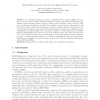Free Online Productivity Tools
i2Speak
i2Symbol
i2OCR
iTex2Img
iWeb2Print
iWeb2Shot
i2Type
iPdf2Split
iPdf2Merge
i2Bopomofo
i2Arabic
i2Style
i2Image
i2PDF
iLatex2Rtf
Sci2ools
137
click to vote
PKC
2012
Springer
2012
Springer
Strongly Secure Authenticated Key Exchange from Factoring, Codes, and Lattices
Abstract. An unresolved problem in research on authenticated key exchange (AKE) is to construct a secure protocol against advanced attacks such as key compromise impersonation and maximal exposure attacks without relying on random oracles. HMQV, a state of the art AKE protocol, achieves both efficiency and the strong security model proposed by Krawczyk (we call it the CK+ model), which includes resistance to advanced attacks. However, the security proof is given under the random oracle model. We propose a generic construction of AKE from a key encapsulation mechanism (KEM). The construction is based on a chosen-ciphertext secure KEM, and the resultant AKE protocol is CK+ secure in the standard model. The protocol gives the first CK+ secure AKE protocols based on the hardness of integer factorization problem, code-based problems, or learning problems with errors. In addition, instantiations under the Diffie-Hellman assumption or its variant can be proved to have strong security without...
Related Content
| Added | 29 Sep 2012 |
| Updated | 29 Sep 2012 |
| Type | Journal |
| Year | 2012 |
| Where | PKC |
| Authors | Atsushi Fujioka, Koutarou Suzuki, Keita Xagawa, Kazuki Yoneyama |
Comments (0)

